SUMMARY
This is AI generated summarization, which may have errors. For context, always refer to the full article.
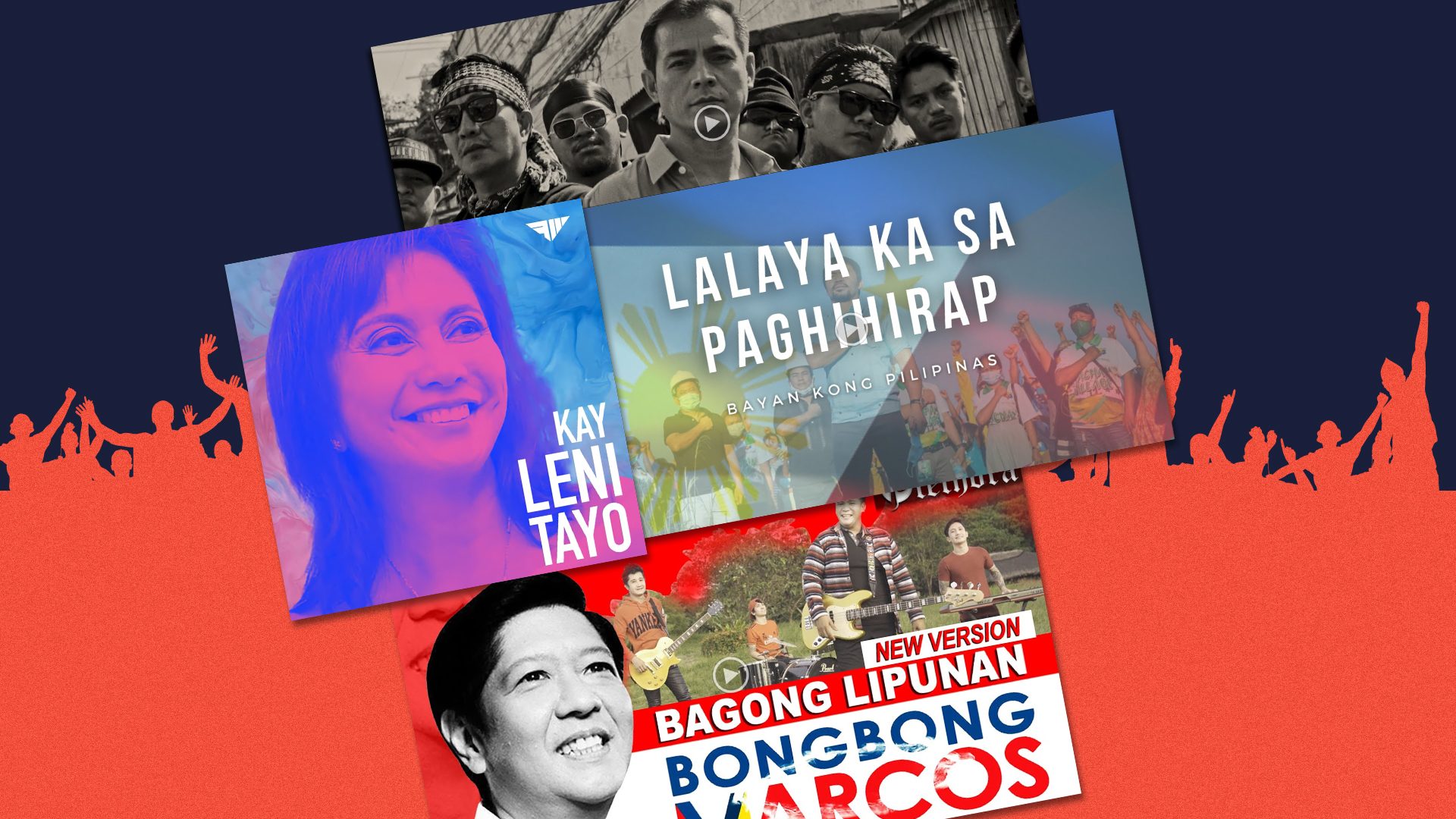
MANILA, Philippines – Once again, voters are experiencing episodes of last song syndrome, thanks to the 2022 elections. But the tunes and melodies are not what we experienced in the past.
Presidential candidates have so far embraced the structure of full-length songs, lasting over three minutes, instead of jingles that last 30 seconds then put on loop.
While song choices are now more complex in structure and are paired with a compelling music video, can melodies actually deliver a candidate to Malacañang?
Raul Navarro, associate professor at the University of the Philippines College of Music, said that songs are powerful tools to build a candidate’s image and keep these images in the consciousness of voters.
“Tandaan natin na parte ng edukasyon ng tao ang musika, kung saan natututuhan natin ang abakada o alpabeto o wikang inaawit…. Kulturang pinapaksa sa awit at maging alaala, relihiyon, o recall sa makasaysayang personalidad,” Navarro said in a webinar organized by the UP Department of Speech Communication and Theatre Arts. (Watch the full episode here.)
(Remember that music is part of the education process, where we learn the alphabet or language that we sing…. Culture is also a topic of songs, even memories, religion, or a recall of a historical personality.)
Campaign songs and music videos have also become more useful for candidates during the pandemic, when people have increased their use of social media and politicians are unable to visit areas due to restrictions. Navarro said, however, that the popularity of a campaign song would not necessarily translate to votes for the candidate.
“[Pero] tandaan natin na minsan nandoon lang ang tagapakinig para hangaan ang likhang musika, not necessarily iboboto ang kandidatong paksa nito,” he added.
(But we must remember that sometimes the listener is only there to admire the music and not necessarily vote for the person who is the subject of the song.)
Rock and roll: Bongbong Marcos
May bagong silang,
May bago nang buhay,
Bagong bansa, bagong galaw,
Sa Bagong Lipunan!
Magbabago ang lahat, tungo sa pag-unlad,
at ating itanghal, bagong lipunan!
Bagong Silang by Felipe Padilla de Leon and Levi Celerio
True to his campaign strategy of reviving the symbols associated with his father, Ferdinand “Bongbong” Marcos Jr. has played the late dictator’s marching song throughout his campaign.
Marcos Sr. commissioned Felipe Padilla de Leon and Levi Celerio to write and compose “Bagong Pagsilang” or “Bagong Lipunan” in 1973, a year after the dictator declared Martial Law.
The song opens with a drum roll, almost sounding like war drums. It demands the audience to stop and listen. It commands respect.
This time, the son, through a band called Plethora, turns it into a modern rock song.

“Nagtatangkang ihiwalay ang awit sa nakaraang malagim na konteksto nito na nilikha ito sa tangkang buuhing New Society ni Ferdinand Marcos sa loob ng lipunang lugmok sa Batas Militar,” Navarro said.
(The new version attempts to separate the song from its gruesome context, which was written for Ferdinand Marcos’s vision of a New Society within a society helplessly trapped in Martial Law.)
“Binago ang dama, inilapit sa sensibilidad ng mga kasalukuyang tagapakinig ng musika. Naglalapit din ang binagong istilo ng kanta sa target audience ng kampanya, ang kabataan na hindi naranasan ang bagsik ng Batas Militar. Isa na lamang itong nakakaaaliw na kanta para sa isang taong walang alaala ng nakalipas.”
(The tune was changed for the sensibilities of the current listeners of music. The new style also draws in the target audience, which is the youth, who have not experienced the atrocities of Martial Law. It is now but just an entertaining song for a person who has no memory of the past.)
If “Bagong Lipunan” commands respect and discipline, Plethora’s original composition, “Tigre at Agila (Tiger and Eagle),” exudes angst. The electric guitar solo further amplifies the promise of grandeur.

Christine Magpayo, an instructor at the UP Department of Speech Communication and Theatre Arts, said that the song wants people to remember the symbols of Marcos Jr. and his partner, Davao City Mayor Sara Duterte.
The song is also successful in reinforcing the claims of Marcos Jr. and Duterte that they are destined for the highest posts of the land.
“They want the people to remember the metaphor. Tigre and agila, it’s repeated, and the melody is quite repetitive as well, and that makes it sticky,” Magpayo said.
Magpayo said that the lineup of songs played throughout the campaign must also be worth noting. For instance, Toni Gonzaga singing Sia and David Guetta’s “Titanium” conveys Marcos’ strategies.
“The song has lines like ‘Shoot me down, but I won’t fall’ – it’s as if the other candidates are just attacking Marcos Jr. It reinforces their narrative that they are being attacked by opponents,” Magpayo said.
Marcos Jr. also uses the song “Umagang Kay Ganda” by Ray-An Fuentes and Tillie Moreno to add to his vision of a new society. The music video features hypnotizing pinwheels, a reference to the iconic windmills in Ilocos Norte built by a private company but which supporters insist on giving Marcos Jr. credit for.
’90s love songs: Leni Robredo
Heto na’ng ating pinuno
Handa nang magsilbi
Husay at tibay, puso at isip
Kay Leni tayo (Leni Robredo, oh)
Kay Leni tayo (Leni Robredo, oh, oh)
Kay Leni Tayo by Nica del Rosario
If Marcos Jr.’s rock songs demand attention, Leni Robredo’s songs are romantic and courts the listener.
g describes Robredo’s songs as feminist and exudes invitational rhetoric.
“It’s very feminist, it’s promoting the principle of equality, safety, and freedom. It’s not a hardcore ‘Vote for me’ type. Invitational rhetoric is when you invite people to share your own perception,” Magpayo said.
Nica del Rosario’s “Kay Leni Tayo,” an upbeat song which has topped Apple Music and Spotify charts, invites voters to listen to Robredo’s platforms and highlights her qualities as a leader. (WATCH: Rappler Talk: The creative process behind the ‘Kay Leni Tayo’ jingle)
Del Rosario pulls the heartstrings in “Rosas,” even going so far as to tell of Robredo’s limitations and vulnerability. It is also the only song, so far, which does not mention Robredo’s name, mentioning only the color associated with her campaign.
At hindi ko maipapangako
Ang kulay rosas na mundo para sa’yo
At hindi ko maiilawan ang lahat ng anino
Pero sisikapin ko at hindi ako magpapahinga
Hangga’t hindi mo pa magawang
Muling ipagmalaki na ika’y isang Pilipino
Rosas by nica del rosario, featuring gab pangilinan
If you feel like crying after listening to “Rosas,” it’s likely because it’s reminiscent of a Korean drama soundtrack, or a lullaby with a dash of the blues.
The slow and emotional song uses a musical technique called word painting, where the literal meaning of the lyrics are reflected in the tone.
“Because of word painting, even without the lyrics, you feel the sentimentality, which makes it a really beautiful song,” Magpayo said.

Meanwhile, “Handa Ka Na Ba kay Leni” of balladeer Ogie Alcasid invites the listener to look into themselves and reflect. Alcasid’s voice gives the listener some familiarity, but the song’s beat and tone departs from his usual romantic style.
“Ogie’s song starts off with a series of questions, something personal. Then the chorus moves the listener by asking ‘Hanggang kailan tayo magtitiis (Until when will we suffer)?’ It moves from personal to something family-oriented, and eventually the bigger picture of collective suffering and hope,” Magpayo said.
Navarro said that “Rosas” and Ogie Alcasid’s “Handa Ka Na Ba kay Leni (Are You Ready for Leni)” have the qualities of a ’90s love song: tender, emotional, and nostalgic of an era in music.
Robredo’s campaign team has also carefully curated songs to reflect their invitational rhetoric. Among the mainstream songs played during Robredo’s sorties are Rivermaya’s “Liwanag sa Dilim (Light in the Darkness)” to symbolize Robredo’s aspirations for the country, and Eraserheads’ “Alapaap,” known for its catchy line, “Gusto mo bang sumama (Do you want to join)?”
Isko Moreno’s rap-musical
Nais lang mabuhay
Ng walang away walang kulay
problema’y matatapos…hanggang makaraos
Sama-sama tayong magtagumpay
Pantay-pantay na pagtingin sa lahat, kayumanggi-maputi o moreno ang balat
kahit di na para satin kundi para na lang sa mga bata kaya’t
Ikaw NaIsko!
Nais Ko by Smugglaz & Bassilyo
Actor-turned-politician Isko Moreno uses rap to tell his biography.
“Nais Ko” by Smugglaz & Bassilyo is a word play on Moreno’s nickname and nais (desire), echoing frustrations and experiences of the masses amid the prevailing political and social order. With his life story and political leanings, he would be the lone candidate in his race to pull off a rap song.
“Rap is very political. Rap as a music genre is a protest against high art. For Isko Moreno to use that is right because it is consistent with his narrative,” Magpayo said.

But rap, as a genre, is still notoriously misogynistic. This stanza, for instance, conveys traditional gender roles:
Lolo ko at si ama kaya lang ay magkarga, Lola ko at si ina kaya lang ay maglaba
Si kuya at si ate si bunso naka-nganga, Naghihintay kung sino saming may biyaya na dala
In the music video, Moreno himself is seen acting. The video starts off with Moreno wearing just an undershirt, then eventually putting on a blue polo while walking in the streets of Manila. These depictions suggest Moreno’s transformation from a simple boy from Tondo to a man aiming for the presidency.
This execution, however, may not work to his favor.
“It’s performative. As much as people want a candidate they can relate to, I think we’re desensitized with performative performances. It’s just performative and we can see through it that he’s making himself relatable. It’s not really working to his favor anymore,” Magpayo said.
Pacquiao’s anthem

Lito Camo’s “Pacman, Bayan Bangon!” Is Senator Manny Pacquiao’s official campaign jingle. The energetic, masculine tune bears Camo’s signature style of repeating lines and words to engrain messages.
The jingle and music video remind the audience of Pacquiao’s journey from being a poor boxer to a Senator. It also emphasizes his deep religious and conservative beliefs.
The jingle and his narrative may not be enough to convince listeners, according to Navarro and Magpayo.
“It may be enough for the Senate, there are 12 seats there. But the presidency demands more,” Magpayo said.
The boxer-turned-senator has also rehashed Freddie Aguilar’s “Bayan Ko (My Country)” to draw in the masses.
Si Manny Pacquiao ay naririto
Handang tulungan ang mga tao
Dahil siya ay nanggaling sa hirap
Ramdam niya ang mga kapuspalad
Bayan Ko by Freddie Aguilar
An iconic, patriotic song associated with the anti-Marcos movement, the original was once deemed seditious by the dictator.
But while Aguilar’s song has made significant impact in the past, it does not mesh well with Pacquiao’s rags-to-riches story.
Navarro said that the song is about patriotism, not about a champion. These songs will likely work better for political issues like China’s incursions in the West Philippine Sea, but not Pacquiao’s campaign.

Halfway through the song, Pacquiao is heard talking about religion, setting a conservative tone should he become president.
“Inserting a speech about God being good all the time, about God blessing everyone…it means that policies will be based on his preferred religion,” g said.
What about Lacson and De Guzman?
Senator Panfilo Lacson and labor leader Leody de Guzman both have the usual campaign jingles, but none stick compared to the frontrunners. Magpayo said that the minimal effort in producing songs is understandable, as it may likely be off-brand for both of them.
Lacson has a volunteer-produced jingle called “Tara Na, Kay Ping Lacson.”
“Boring daw ako. Pero hindi ang kantang ito. Maraming salamat sa supporters na gumawa, nakaka-indak at nakaka-LSS din! (They say I’m boring, but not this song. Thank you to the supporters who made this, it makes you want to dance and gives you the LSS),” the caption read. The jingle just has a little over 23,000 views.
Lacson, however, has consistently refused to engage the way other candidates have. He has focused on attending debates to convey his platform.
De Guzman may have a missed opportunity in not using the songs of the Left. After all, activists have plenty of catchy songs on their playlist.
De Guzman only has “Manggagawa Naman” by Adrian Jimenez, a rap jingle which seeks to convince voters to choose a labor leader to be their next chief executive.
Sa manggagawa naman ang manibela ipahawak hindi sa mga trapong lagi kang pinapahamak. Silang kapag nanalo at sa trono nakatapak. Burgis na kapitalista lamang ang makikinabang.
Manggagawa Naman by Adrian Jimenez
–Rappler.com
Add a comment
How does this make you feel?
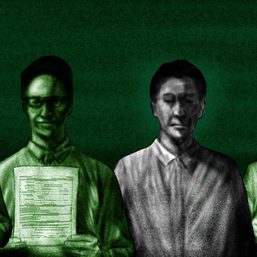
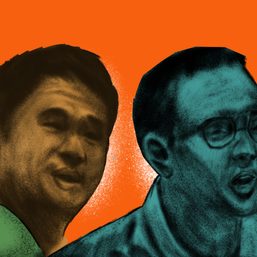
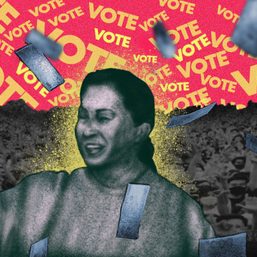

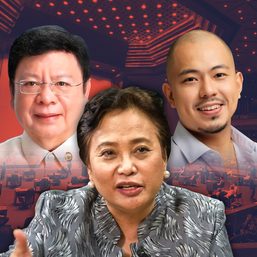

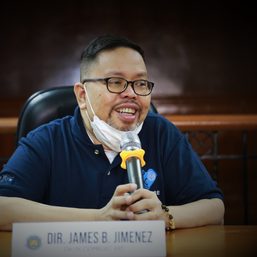
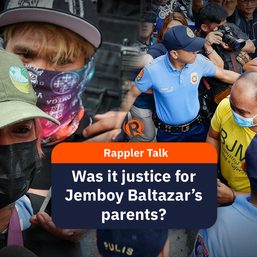
![[New School] Tama na kayo](https://www.rappler.com/tachyon/2024/02/new-school-tama-na-kayo-feb-6-2024.jpg?resize=257%2C257&crop=290px%2C0px%2C720px%2C720px)
![[Only IN Hollywood] After a thousand cuts, and so it begins for Ramona Diaz and Maria Ressa](https://www.rappler.com/tachyon/2024/02/Leni-18.jpg?resize=257%2C257&crop=262px%2C0px%2C720px%2C720px)
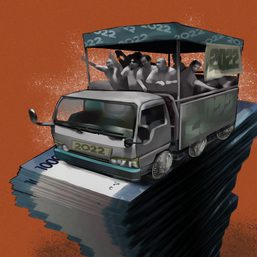
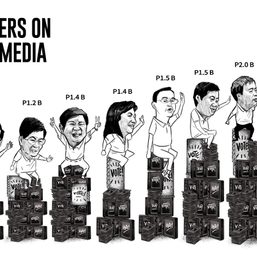
![[Stakeout] Ganid na ‘PR handler’ ang pahirap sa Pinoy](https://www.rappler.com/tachyon/2022/04/tl-3.jpg?resize=257%2C257&crop=430px%2C0px%2C1080px%2C1080px)
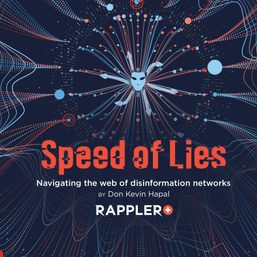
There are no comments yet. Add your comment to start the conversation.